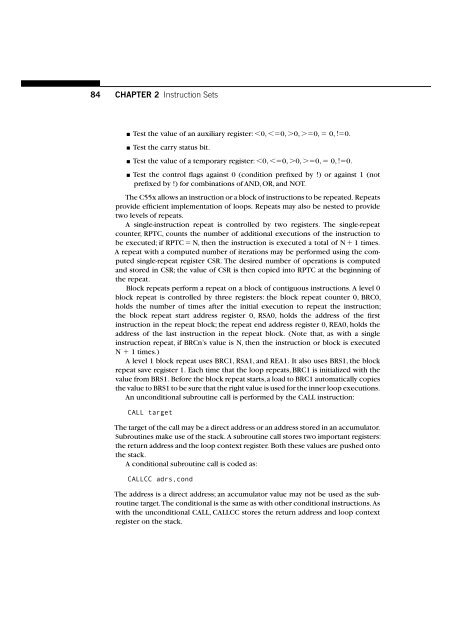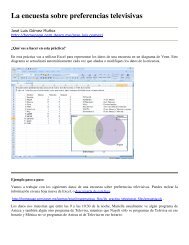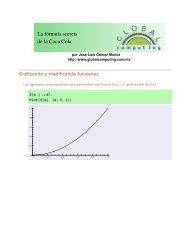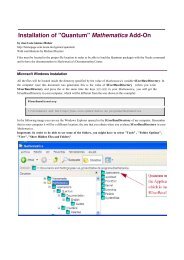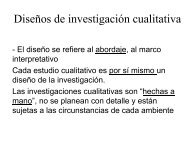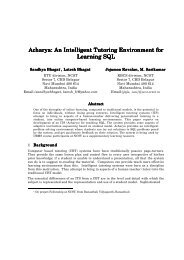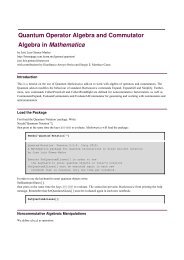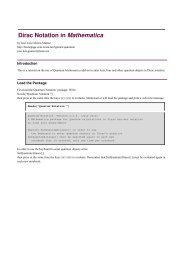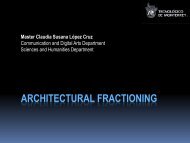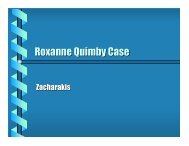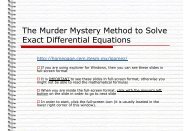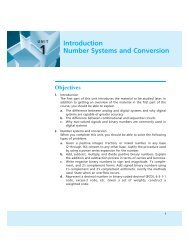Instruction Sets
Instruction Sets
Instruction Sets
You also want an ePaper? Increase the reach of your titles
YUMPU automatically turns print PDFs into web optimized ePapers that Google loves.
84 CHAPTER 2 <strong>Instruction</strong> <strong>Sets</strong>■ Test the value of an auxiliary register: 0, 0, 0, 0, 0, !0.■ Test the carry status bit.■ Test the value of a temporary register: 0, 0, 0, 0, 0, !0.■ Test the control flags against 0 (condition prefixed by !) or against 1 (notprefixed by !) for combinations of AND, OR, and NOT.The C55x allows an instruction or a block of instructions to be repeated. Repeatsprovide efficient implementation of loops. Repeats may also be nested to providetwo levels of repeats.A single-instruction repeat is controlled by two registers. The single-repeatcounter, RPTC, counts the number of additional executions of the instruction tobe executed; if RPTC N, then the instruction is executed a total of N 1 times.A repeat with a computed number of iterations may be performed using the computedsingle-repeat register CSR. The desired number of operations is computedand stored in CSR; the value of CSR is then copied into RPTC at the beginning ofthe repeat.Block repeats perform a repeat on a block of contiguous instructions. A level 0block repeat is controlled by three registers: the block repeat counter 0, BRC0,holds the number of times after the initial execution to repeat the instruction;the block repeat start address register 0, RSA0, holds the address of the firstinstruction in the repeat block; the repeat end address register 0, REA0, holds theaddress of the last instruction in the repeat block. (Note that, as with a singleinstruction repeat, if BRCn’s value is N, then the instruction or block is executedN 1 times.)A level 1 block repeat uses BRC1, RSA1, and REA1. It also uses BRS1, the blockrepeat save register 1. Each time that the loop repeats, BRC1 is initialized with thevalue from BRS1. Before the block repeat starts,a load to BRC1 automatically copiesthe value to BRS1 to be sure that the right value is used for the inner loop executions.An unconditional subroutine call is performed by the CALL instruction:CALL targetThe target of the call may be a direct address or an address stored in an accumulator.Subroutines make use of the stack. A subroutine call stores two important registers:the return address and the loop context register. Both these values are pushed ontothe stack.A conditional subroutine call is coded as:CALLCC adrs,condThe address is a direct address; an accumulator value may not be used as the subroutinetarget.The conditional is the same as with other conditional instructions.Aswith the unconditional CALL, CALLCC stores the return address and loop contextregister on the stack.


